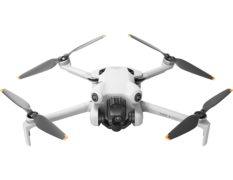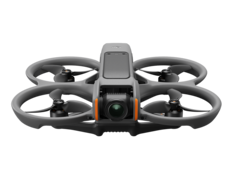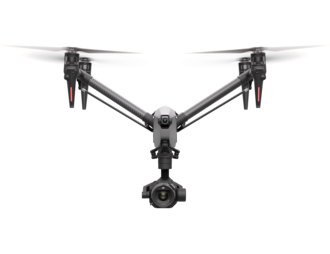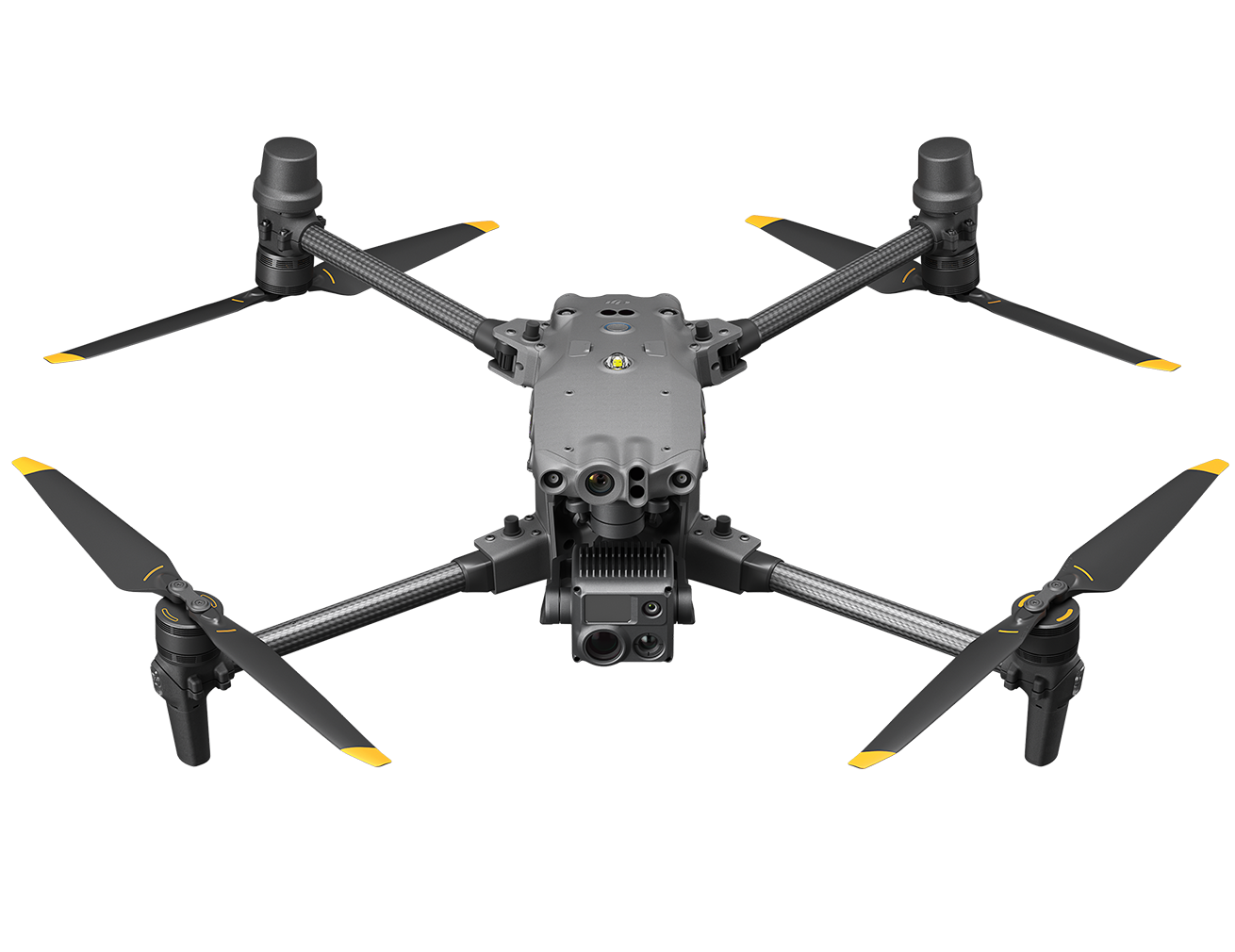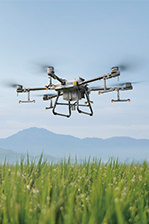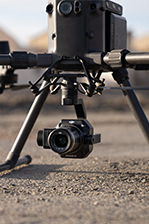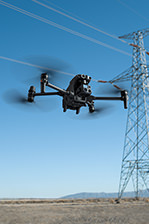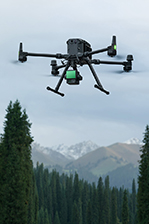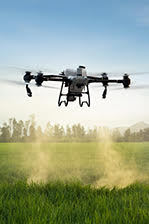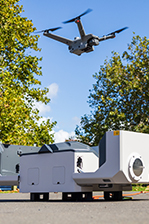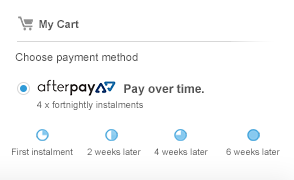DJI Mavic 4 Pro 512GB Creator Combo (DJI RC Pro 2)
The DJI Mavic 4 Pro features a 100MP Hasselblad camera, triple-lens system, 360° Infinity Gimbal, and advanced obstacle sensing. Capture stunning aerial content with up to 51 minutes of flight time and 30km 10-bit HDR video transmission.
Spin Your World
100MP Hasselblad main camera, large CMOS dual tele cameras, Infinity Gimbal with 360° rotation, 0.1-Lux Nightscape Omnidirectional Obstacle Sensing, O4+ Video Transmission...DJI Mavic 4 Pro is a game-changer, boasting cutting-edge features that redefine our technology and take DJI drone imaging and flight performance to unprecedented levels. This triple-camera flagship drone is set to transform how you create and explore new horizons in aerial photography.
100MP 4/3 CMOS Hasselblad Camera With 6K/60fps HDR Video
1/1.3″ & 1/1.5″ Large CMOS Dual Tele Cameras
Infinity Gimbal With 360° Rotation for Dynamic Camera Movement
0.1-Lux Nightscape Omnidirectional Obstacle Sensing[2]
51-Min Flight Time[3]
DJI O4+ 30km 10-bit HDR Video Transmission[4]
Collapsible Remote Controller With 7″ Rotatable High-Bright Display[5]
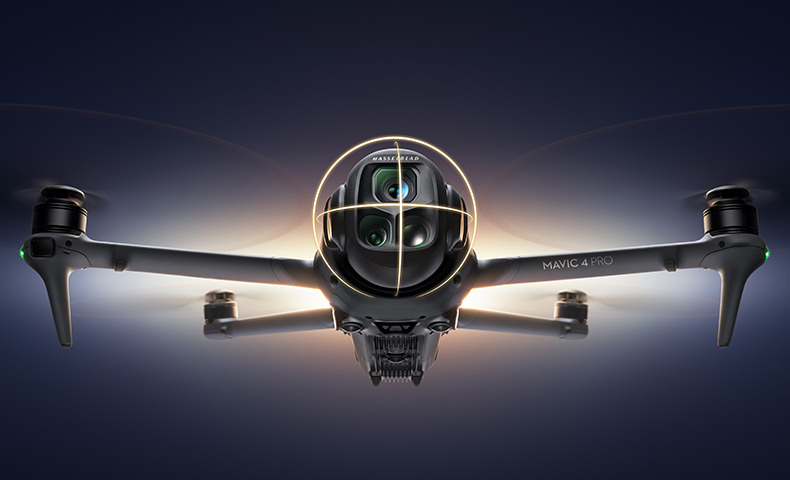
Triple-Camera Imaging System
Master Every Angle
Introducing the advanced triple-camera system, where each lens excels, capturing exceptional images ranging from expansive wide-angle landscapes to detailed telephoto close-ups. All three cameras boast Dual Native ISO Fusion, which seamlessly blends the benefits of high and low ISO settings to capture stunning details beyond what traditional solutions can achieve. Plus, ignite your creativity with high-resolution RAW stacking of up to 5 frames, along with features like Free Panoramas and Subject Focusing across all cameras.
4/3 CMOS Hasselblad Main Camera
The meticulously crafted 4/3 CMOS Hasselblad camera utilizes a brand-new 100MP sensor and supports the renowned Hasselblad Natural Color Solution (HNCS) for exceptional color fidelity. It captures breathtaking 100MP images packed with detail and sharpness, offering unprecedented flexibility in post-processing. The lens has been reengineered to meet the demands of the 100MP sensor, delivering incredible sharpness. A versatile f/2.0 to f/11 aperture allows for clean low-light filming, while also rendering eye-catching 10-ray starburst effects.
Medium Tele Camera
Equipped with a 48MP 1/1.3-inch sensor and f/2.8 aperture, the 70mm medium tele camera delivers enhanced image quality due to its new image processing engine. The 70mm focal length creates compressed perspectives to highlight subjects, ideal for dynamic portraits and footage with orbital camera movements.
Tele Camera
Powered by a 50MP 1/1.5-inch sensor and a wide f/2.8 aperture, the tele camera leverages a specifically optimized gimbal algorithm tailored for its telephoto optics to deliver unparalleled image quality and stability in long-range aerial photography. Its extended reach dramatically reduces depth perception, creating a flattened perspective that isolates subjects with remarkable clarity. Combined with Subject Focusing, capturing breathtaking close-ups becomes effortless. Plus, it captures incredibly detailed Free Panoramas, revealing expansive skylines when zoomed out and intricate cityscapes when zoomed in.
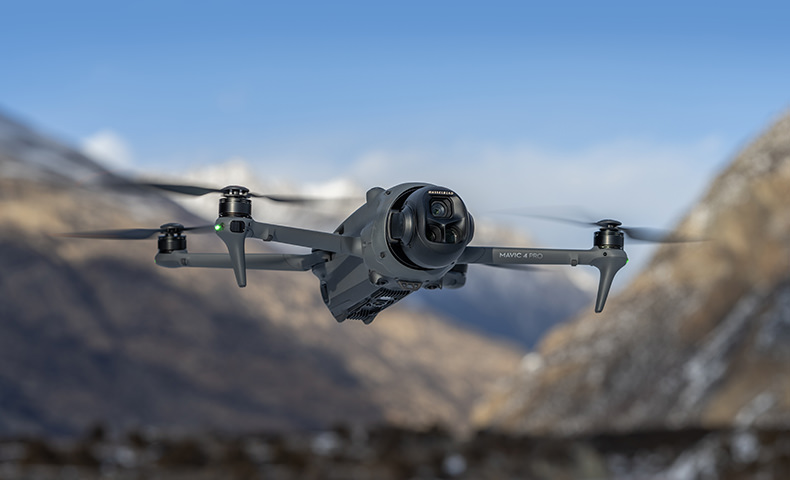
Pro-Grade Video
6K/60fps HDR Videos
All three cameras support 4K/60fps HDR video recording. The Hasselblad main camera elevates this capability by enabling 6K/60fps HDR video and an impressive dynamic range of up to around 16 stops[6]. The medium tele and tele cameras offer dynamic ranges of 14 stops and 13 stops respectively.
4K/120fps Slow Motion
Both the Hasselblad main camera and the medium tele camera support 4K/120fps video recording, while the tele camera records in 4K/100fps [7]. High resolution and elevated frame rates provide greater flexibility in post-production. When filming portrait, skiing, and wildlife, slow-motion footage captured with the tele camera adds dramatic tension and visual impact to your work.
10-bit D-Log & All-I 4:2:2 Encoding
All three cameras feature 10-bit D-Log, D-Log M, and HLG color profiles, ensuring consistent color reproduction across your footage. The Mavic 4 Pro 512GB version in the Creator Combo further enhances your workflow with 10-bit 4:2:2 video recording through All-I encoding. This capability captures richer color details, offering a superior editing experience.
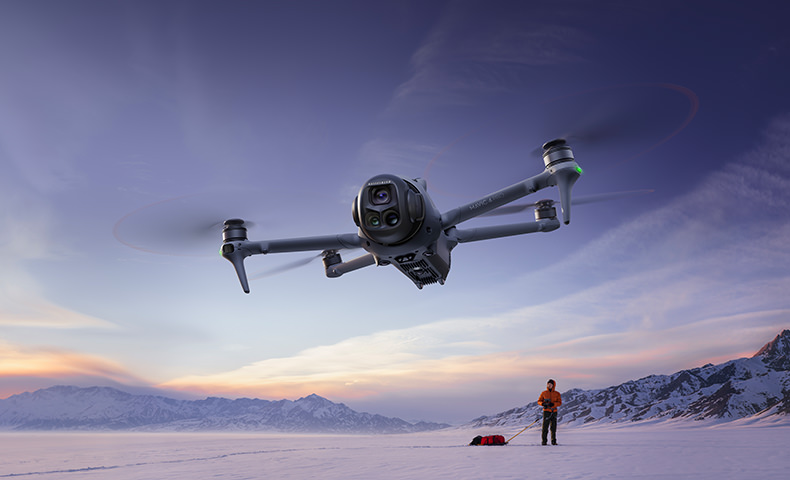
Capture the Unseen With Prime Build
Infinity Gimbal: World in Motion
Break creative boundaries with the revolutionary Infinity Gimbal. The innovative gimbal structure allows for effortless 70° upward shots and full 360° rotation [8] for unprecedented angles. Capture dramatic Dutch angles straight from the camera or reimagine aerial storytelling with fluid, gravity-defying movements.
360° Rotation: Capture mind-blowing aerial rolls with stunning quality, straight from your drone.
70° Upward Shots: Frame mountains and architectural marvels through bold, dynamic perspectives, unlocking endless possibilities for creative compositions.
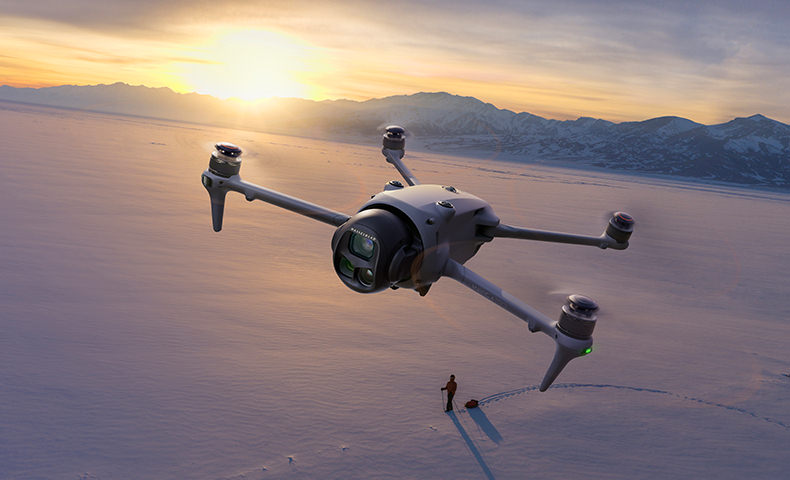
Sharp Vision, Smooth Navigation
ActiveTrack 360° Just Got More Powerful
ActiveTrack 360° [9] excels even in low-light scenarios like in twilight or under city lights [2], delivering cinematic tracking with enhanced stability. Once tracking begins, Mavic 4 Pro can keep the subject in focus even if the lower half of their body is partially obscured by bushes or if they are standing on a bridge. It also detects vehicles up to 200m [10] with directional awareness, delivering professional-grade automotive cinematography.
ActiveTrack 360° on Mavic 4 Pro is significantly improved for vehicle-tracking, offering versatile performance to meet a wide range of filming needs.
See In All Directions With Nightscape Omnidirectional Vision [11]
Mavic 4 Pro is equipped with six high-performance, low-light fisheye sensors with a sensitivity of 0.1 lux and dual processors for high-resolution environmental awareness. It achieves omnidirectional obstacle avoidance at speeds up to 18 m/s in low light, using streetlight illumination to detect and avoid obstacles during flight. Whether navigating through canyons or urban landscapes with poor satellite signals, this high-performance visual system ensures precise drone positioning. In near-pitch-black environments with brightness below 0.1 lux, it can still use its forward-facing LiDAR to detect obstacles ahead and quickly brake to avoid collisions.
0.1-Lux Nightscape Omnidirectional Obstacle Sensing: Provides robust safety for night photography, allowing you to create with confidence and efficiency.
Nighttime RTH: With the forward-facing LiDAR, Mavic 4 Pro detects obstacles like tall buildings even in low-light conditions and intelligently maneuvers upward [12], ensuring safer returns during nighttime flights.
Non-GPS RTH: Powered by real-time vision positioning and map construction technologies, Mavic 4 Pro memorizes flight paths when adequate lighting is available. This ensures a safe return [13] even when taking off from locations without satellite signals, such as balconies.
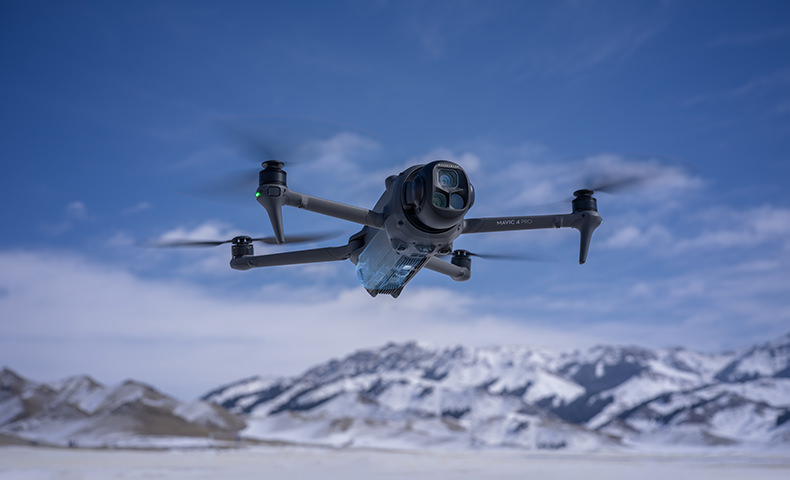
Fly Longer, Stay Connected
51-Min Flight Time [3]
Mavic 4 Pro’s aerodynamic design, efficient propulsion system, and 95Wh battery deliver flight times of up to 51 minutes, top speeds of up to 90 km/h, and a range of 41 km (25.4 miles) [3]. Whether you're scouting locations, practicing maneuvers, capturing time-lapse shots, or taking panoramic photos with a telephoto lens, the ample flight time allows you to operate with ease and confidence.
DJI O4+ 10-bit HDR Video Transmission
Mavic 4 Pro features the DJI O4+ transmission system, which leverages next-generation proprietary algorithms to unlock the full potential of its hardware. It enables ultra-long-range 10-bit HDR image transmission up to 30 km (18.6 miles)[4] and reduces the likelihood of disconnection in highly interfered environments, such as urban areas. In addition, the O4+ video transmission system is optimized for multi-drone flights, ensuring robust resistance to interference.
.jpg)
Thoughtful Design Simple and Efficient
Power Up Fast, Get Ready Faster
Unfold to Power On: Simply extend the arms to power on your Mavic 4 Pro. With advanced flight path memory, it automatically updates the home point [12] even without GPS.
Remote Controller Ready in Seconds: The DJI RC Pro 2 remote controller also powers on when extended, allowing you to start creating without delay.
One Battery Drained, the Other One Ready
With the DJI Mavic 240W Power Adapter [5], the Mavic 4 Pro Parallel Charging Hub fully charges one battery in 51 minutes and can charge three batteries at the same time via the Mini SDC port. The Parallel Charging Hub boosts efficiency by prioritizing the battery with the lowest charge. Once all three batteries reach the same charge level, it switches to parallel charging, fully charging all three batteries in just 90 minutes [14].
By leveraging the batteries' stored power, the Parallel Charging Hub can also transform into a 100W power bank, providing a convenient way to fast-charge phones and laptops on location. Additionally, it features a power accumulation function, which allows you to transfer the remaining power of multiple low-power batteries into the battery with the highest remaining power [16].
Built-In 512GB SSD
The DJI Mavic 4 Pro comes with a 64 GB storage module [17], so you can start capturing right away without an external memory card. The Mavic 4 Pro in the Creator Combo features a built-in 512 GB high-capacity SSD [18], supporting high-spec ALL-I 4:2:2 encoded video recording and time-lapse photography with intervals as short as 1 second, ensuring you're always ready to capture your next masterpiece.
100MP RAWs Transferred In Seconds!
With QuickTransfer, there's no need to take the drone [19] and controller out of your bag to transfer footage. Simply wake Mavic 4 Pro remotely via the DJI Fly app, and transfer files at speeds up to 80MB/s over Wi-Fi 6. Even when switching apps, the DJI Fly app continues downloading smoothly in the background. To easily transfer footage to a computer, simply connect the drone to a computer via a compatible USB cable without needing to power on the drone.
Notes
* All videos and images on this page were shot using DJI Mavic 4 Pro by professionals in strict compliance with local laws and regulations and have been variously edited in post-production. All videos and images are for reference only. Actual results may vary. Always observe local laws and regulations and ensure the aircraft has obtained relevant certifications and airspace authorizations before flying. All images and videos containing wildlife on this page were captured in strict compliance with local wildlife protection regulations.
** All data on this page was collected with a production model of DJI Mavic 4 Pro in a controlled test environment. Actual experience may vary depending on the environment, usage, and firmware version. DJI Mavic 4 Pro must be activated via the DJI Fly app before use.
*** It is recommended to use the ActiveTrack 360° feature in open environments. Refer to the user manual for unsupported scenarios or those that may potentially interrupt recording. In complex environments with many obstacles, exercise caution when using Auto mode to ensure flight safety and personal safety.
**** All images, videos, and screen displays contents about the product itself on this page are for reference only. Actual product effects (including but not limited to appearance, color, and size) and screen display contents (including but not limited to backgrounds, UI, and illustrations) may vary.
- Supports adjustments ranging from ND4 to ND64. Accessory not included with the standard package or Fly More Combo. If needed, it is included in the Creator Combo, or can be purchased separately.
- This feature only operates effectively on surfaces with discernible textures and in lighting conditions equal to or exceeding 0.1 lux. For details, please refer to the user manual.
- Measured by the aircraft flying forward at a constant speed of 9 m/s (32.4 km/h) in a windless environment at sea level, with Obstacle Avoidance Action set to Brake, in photo mode, and from 100% battery level until 0%. Data is for reference only. Always pay attention to reminders in the app during your flight.
- Measured in an outdoor, open environment, without interference, and with FCC compliance. The 30 km transmission distance is only achievable under FCC standards; in mainland China, the SRRC standard is adopted, with a maximum transmission distance of 15 km. The above data shows the farthest communication range for one-way, non-return flights. Always pay attention to reminders in the app during your flight.
- Accessory included with the Creator Combo. Not included with the standard package or the Fly More Combo.
- Around 16 stops of dynamic range are achievable for video on Auto mode, but not for cropped vertical shooting in certain specifications or slow-motion shooting.
- 4K/120fps and 4K/100fps video is only supported in Slow-Motion mode.
- The gimbal's range of motion may vary based on the angles of each axis, wind speed, and flight speed. Please refer to the actual operation experience and pay attention to the prompts in the DJI Fly app.
- The tele camera only supports Spotlight mode in FocusTrack.
- The 200-meter range is a theoretical value derived from a tracked subject occupying at least 5% of the frame. This is for reference only and may vary based on your usage experience.
- Conditions for enabling nightscape omnidirectional obstacle sensing: The drone's front, back, left, right, or top sides are within range of surfaces with discernible textures with illuminance that exceeds 0.1 lux. Similarly, the ground below is textured and diffusely reflective with a reflectivity above 20% (such as walls, trees, or people), also in lighting conditions with illuminance higher than 0.1 lux. DO NOT fly in severe weather conditions, such as in strong winds (wind speed of 12 m/s or more), snow, rain, lightning, or fog. DO NOT fly the aircraft 6,000m (19,685ft.) or higher above sea level. DO NOT fly the aircraft in environments where the temperature is below -10° C (14° F) or above 40° C (104° F). DO NOT take off from moving objects, such as cars or boats. DO NOT fly close to reflective surfaces such as water or snow. Otherwise, the vision system may be limited. When the GNSS signal is weak, fly the aircraft in environments with good lighting and visibility: The drone's front, back, left, right, and top sides are near textured surfaces with illuminance exceeding 10 lux. Similarly, the ground below is textured and diffusely reflective with a reflectivity above 20%, also in lighting conditions with illuminance higher than 10 lux. The vision system may not work properly in dim environments. DO NOT fly near areas with magnetic or radio interference. Common magnetic or radio interference sources include Wi-Fi hotspots, routers, Bluetooth devices, high-voltage lines, large-scale power transmission stations, radar stations, mobile base stations, and broadcasting towers. Avoid sand entering the aircraft when taking off in desert or beach areas. Fly the aircraft in open areas away from crowds. Buildings, mountains, and trees may block the GNSS signal and affect the onboard compass.
- If the drone reaches its altitude limit while ascending around obstacles, it will hover at that height.
- Conditions for memorizing flight paths: The drone's front, back, left, right, and top sides are near textured surfaces with illuminance exceeding 10 lux. Similarly, the ground below is textured and diffusely reflective with a reflectivity above 20% (such as walls, trees, or people), also in lighting conditions with illuminance higher than 10 lux. If the drone is taking off from a balcony, ensure the usable space is at least 2 meters by 2 meters, and the height above ground is less than 30 meters to ensure a safe return to home.
- Charging time is measured in a test environment with a temperature of 25° C. Actual charging time may increase due to higher ambient temperatures or variations in mains voltage between regions.
- This accessory is not included in the standard package. Available separately or as part of a compatible bundle.
- DO NOT connect the charger, connect external devices, or insert/remove any batteries during power accumulation.
- The actual available storage space is approximately 42 GB.
- The actual available storage space is approximately 460 GB.
- Mavic 4 Pro keeps Bluetooth active for 12 hours after power-off, enabling direct smartphone connections without powering up the drone again. Bluetooth automatically deactivates 12 hours after the drone is powered off.
- Sold separately.
Product Specifications
Aircraft
Takeoff Weight: Approx. 1063 g
Product weight may vary due to differences in batch materials and other factors.
Dimensions: Folded (with propellers): 257.6×124.8×106.6 mm (L×W×H)
Folded (without propellers): 257.6×124.8×103.4 mm (L×W×H)
Unfolded (without propellers): 328.7×390.5×135.2 mm (L×W×H)
Max Ascent Speed: 10 m/s (Sport Mode)
6 m/s (Normal Mode)
6 m/s (Cine Mode)
Max Descent Speed: 10 m/s (Sport Mode)
6 m/s (Normal Mode)
6 m/s (Cine Mode)
Max Horizontal Speed: At sea level, in windless conditions:
25 m/s* (Sport Mode)
18 m/s (tracking status)
At sea level, with 2 m/s tailwind, while flying in the same direction as the wind:
27 m/s* (Sport Mode)
18 m/s (tracking status)
* Measured in a wind tunnel test environment with the aircraft taking off from an altitude of 0 m and ascending vertically by 1.5 m in Sport mode. Data is for reference only. Always pay attention to reminders on the camera view during your flight.
Max Takeoff Altitude: 6000 m
Maximum takeoff altitude is 3000 m with DJI Mavic 4 Pro Propeller Guards.
Max Flight Time: 51 minutes
Measured by the aircraft flying forward at a constant speed of 32.4 kph in a windless environment at sea level, with Obstacle Avoidance Action set to Brake, in photo mode, and from 100% battery level until 0%. Actual experience may vary depending on the environment, usage, and firmware version.
Max Hovering Time: 45 minutes
Measured by the aircraft hovering in a windless environment at sea level, with Obstacle Avoidance Action set to Brake, in photo mode, and from 100% battery level until 0%. Actual experience may vary depending on the environment, usage, and firmware version.
Max Flight Distance: 41 km
Measured by the aircraft flying forward at a constant speed of 54 kph in a windless environment at sea level, with Obstacle Avoidance Action set to Brake, in photo mode, and from 100% battery level until 0%. Actual experience may vary depending on the environment, usage, and firmware version.
Max Wind Speed Resistance: 12 m/s (39.4 ft/s)
Max Pitch Angle: 35°
Operating Temperature: -10 °C to 40 °C (14 °F to 104 °F)
Global Navigation Satellite System: GPS + Galileo + BeiDou
Hovering Accuracy Range: Vertical:
±0.1 m (with vision positioning)
±0.5 m (with satellite positioning)
Horizontal:
±0.3 (with vision positioning)
±0.5 m (with satellite positioning)
Internal Storage: Mavic 4 Pro: 64GB (available storage space is approximately 42GB)
Mavic 4 Pro 512GB (Creator Combo): 512GB (available storage space is approximately 460GB)
Class: C2 (EU)
Camera
Image Sensor: Hasselblad Camera: 4/3 CMOS, Effective Pixels: 100 MP
Medium Tele Camera: 1/1.3-inch CMOS, Effective Pixels: 48 MP
Tele Camera: 1/1.5-inch CMOS, Effective Pixels: 50 MP
Lens: Hasselblad Camera
FOV: 72°
Format Equivalent: 28 mm
Aperture: f/2.0 to f/11
Focus: 2 m to ∞
Medium Tele Camera
FOV: 35°
Format Equivalent: 70 mm
Aperture: f/2.8
Focus: 3 m to ∞
Tele Camera
FOV: 15°
Format Equivalent: 168 mm
Aperture: f/2.8
Focus: 3 m to ∞
ISO Range: Hasselblad Camera
Video
Normal:
100-12800 (Normal)
400-6400 (D-Log)
100-6400 (D-Log M)
100-6400 (HLG)
Slow Motion:
100-6400 (Normal)
400-3200 (D-Log)
100-3200 (D-Log M)
100-3200 (HLG)
Photo
100-6400 (25 MP)
100-3200 (100 MP)
Medium Tele Camera and Tele Camera
Video
Normal:
100-12800 (Normal)
400-3200 (D-Log)
100-3200 (D-Log M)
100-3200 (HLG)
Slow Motion:
100-6400 (Normal)
400-3200 (D-Log)
100-3200 (D-Log M)
100-3200 (HLG)
Photo
100-6400 (12 MP)
100-3200 (48 MP and 50 MP)
Shutter Speed: Hasselblad Camera
25MP Single Shot: 1/16000-16 s (over 2 s for simulated long exposure)
100MP Single Shot: 1/8000-8 s
25 MP Auto Exposure Bracketing (AEB)/Burst Shooting/Timed: 1/16000-8 s
100 MP Auto Exposure Bracketing (AEB)/Burst Shooting/Timed: 1/8000-8 s
Medium Tele Camera
12 MP Single Shot: 1/16000-8 s (over 2 s for simulated long exposure)
48 MP Single Shot: 1/8000-2 s
12 MP Auto Exposure Bracketing (AEB)/Burst Shooting/Timed: 1/16000-2 s
48 MP Auto Exposure Bracketing (AEB)/Burst Shooting/Timed: 1/8000-2 s
Tele Camera
12.5 MP Single Shot: 1/16000-8 s (over 1 s for simulated long exposure)
50 MP Single Shot: 1/16000-2 s
12.5 MP Auto Exposure Bracketing (AEB)/Burst Shooting/Timed: 1/16000-2 s
50 MP Auto Exposure Bracketing (AEB)/Burst Shooting/Timed: 1/16000-2 s
Max Image Size: Hasselblad Camera: 12288 × 8192
Medium Tele Camera: 8064 × 6048
Tele Camera: 8192 × 6144
Still Photography Modes: Hasselblad Camera
Single Shot: 25 MP, 100 MP
Automatic Exposure Bracketing (AEB): 25 MP, 3/5/7 frames at 0.7 EV step;100 MP, 3/5 frames at 0.7 EV step
Burst Shooting: 25 MP, 3/5/7 frames; 100 MP, 3/5 frames
Timed: 25 MP, 1 (Mavic 4 Pro 512GB)/2/3/5/7/10/15/20/30/60 seconds; 100 MP, 2 (Mavic 4 Pro 512GB)/3 (Mavic 4 Pro 512GB)/5 (Mavic 4 Pro 512GB)/7 (Mavic 4 Pro 512GB)/10/15/20/30/60 seconds
Medium Tele Camera
Single Shot: 12 MP, 48 MP
Automatic Exposure Bracketing (AEB): 12 MP, 3/5/7 frames at 0.7 EV step; 48 MP, 3/5/7 frames at 0.7 EV step
Burst Shooting: 12 MP, 3/5/7 frames; 48 MP, 3/5/7 frames
Timed: 12 MP, 1 (Mavic 4 Pro 512GB)/2/3/5/7/10/15/20/30/60 seconds; 48 MP, 1 (Mavic 4 Pro 512GB)/2 (Mavic 4 Pro 512GB)/3 (Mavic 4 Pro 512GB)/5/7/10/15/20/30/60 seconds
Tele Camera
Single Shot: 12.5 MP, 50 MP
Auto Exposure Bracketing (AEB): 12.5 MP, 3/5/7 frames at 0.7 EV step; 50 MP, 3/5/7 frames at 0.7 EV step
Burst Shooting: 12.5 MP, 3/5/7 frames; 50 MP, 3/5/7 frames
Timed: 12.5 MP, 1 (Mavic 4 Pro 512GB)/2/3/5/7/10/15/20/30/60 seconds; 50 MP, 1 (Mavic 4 Pro 512GB)/2 (Mavic 4 Pro 512GB)/3 (Mavic 4 Pro 512GB)/5/7/10/15/20/30/60 seconds
Photo Format: JPEG
DNG (RAW)
Video Resolution: Hasselblad Camera
H.264 ALL-I/H.265*
6K: 6016×3384@24/25/30/48/50/60fps
DCI 4K: 4096×2160@24/25/30/48/50/60/120**fps
4K: 3840×2160@24/25/30/48/50/60/120**fps
FHD: 1920×1080@24/25/30/48/50/60fps
4K Vertical Shooting: 2160×3840@24/25/30/48/50/60fps
H.264 Standard
FHD: 1920×1080@24/25/30/48/50/60fps
Medium Tele Camera H.264 ALL-I/H.265 Standard*
4K: 3840×2160@24/25/30/48/50/60/120*fps
FHD: 1920×1080@24/25/30/48/50/60fps
2.7K Vertical Shooting: 1512×2688@24/25/30/48/50/60fps
H.264 Standard
FHD: 1920×1080@24/25/30/48/50/60fps
2.7K Vertical Shooting: 1512×2688@24/25/30/48/50/60fps
Tele Camera
H.264 ALL-I/H.265 Standard
4K: 3840×2160@24/25/30/48/50/60/100**fps
FHD: 1920×1080@24/25/30/48/50/60fps
2.7K Vertical Shooting: 1512×2688@24/25/30/48/50/60fps
H.264 Standard
FHD: 1920×1080@24/25/30/48/50/60fps
2.7K Vertical Shooting: 1512×2688@24/25/30/48/50/60fps
* Only Mavic 4 Pro 512GB (Creator Combo) supports H.264 ALL-I recording.
** Recording frame rates. The corresponding video plays as a slow-motion video.
Video Format: MP4 (H.264 ALL-I/H.264 Standard/H.265 Standard)
Only Mavic 4 Pro 512GB (Creator Combo) supports H.264 ALL-I recording.
Max Video Bitrate: H.264 Standard Bitrate: 90 Mbps
H.265 Standard Bitrate: 180 Mbps
H.264 ALL-I Bitrate: 1200 Mbps
Only Mavic 4 Pro 512GB (Creator Combo) supports H.264 ALL-I recording.
Supported File System: exFAT
Color Mode and Sampling Method: Hasselblad Camera
Normal Color:
10-bit 4:2:2 (H.264 ALL-I)
10-bit 4:2:0 (H.265 Standard)
8-bit 4:2:0 (H.264 Standard)
HLG/D-Log M/D-Log:
10-bit 4:2:2 (H.264 ALL-I)
10-bit 4:2:0 (H.265 Standard)
Medium Tele Camera
Normal Color:
10-bit 4:2:2 (H.264 ALL-I)
10-bit 4:2:0 (H.265 Standard)
8-bit 4:2:0 (H.264 Standard)
HLG/D-Log M/D-Log:
10-bit 4:2:2 (H.264 ALL-I)
10-bit 4:2:0 (H.265 Standard)
Tele Camera
Normal Color:
10-bit 4:2:2 (H.264 ALL-I)
10-bit 4:2:0 (H.265 Standard)
8-bit 4:2:0 (H.264 Standard)
HLG/D-Log M/D-Log:
10-bit 4:2:2 (H.264 ALL-I)
10-bit 4:2:0 (H.265 Standard)
Only Mavic 4 Pro 512GB (Creator Combo) supports H.264 ALL-I recording.
Digital Zoom: Hasselblad Camera: 1x to 2.5x
Medium Tele Camera: 2.5x to 6x
Tele Camera: 6x to 24x
Stabilization: 3-axis mechanical gimbal (tilt, roll, pan)
Gimbal
Mechanical Range: Tilt: -164° to 160°
Roll: -90° to 450°
Pan: -22° to 22°
Controllable Range: Tilt: -90° to 70°
Roll: -40° to 400°
Max Control Speed: Tilt: 100°/s
Roll: 100°/s
Angular Vibration Range: Hovering Without Wind: ±0.001°
Normal Mode: ±0.003°
Sport Mode: ±0.005°
Sensing
Sensing Type: Omnidirectional binocular vision system, supplemented with forward-facing LiDAR and an infrared sensor at the bottom of the aircraft
Forward: Measurement Range: 0.5-24 m
Detection Range: 0.5-200 m
Effective Sensing Speed: Flight Speed ≤ 18 m/s
FOV: Horizontal 180°, Vertical 180°
Backward: Measurement Range: 0.5-22 m
Detection Range: 0.5-200 m
Effective Sensing Speed: Flight Speed ≤ 18 m/s
FOV: Horizontal 180°, Vertical 180°
Lateral: Measurement Range: 0.5-21 m
Detection Range: 0.5-200 m
Effective Sensing Speed: Flight Speed ≤ 18 m/s
FOV: Horizontal 180°, Vertical 180°
Upward: Measurement Range: 0.5-18 m
Effective Sensing Speed: Flight Speed ≤6 m/s
FOV: Horizontal 90°, Vertical 90°
Downward: Measurement Range: 0.5-17 m
Effective Sensing Speed: Flight Speed ≤6 m/s
FOV: Horizontal 180°, vertical 180°
Operating Environment: Forward, Backward, Left, Right, and Upward:
Surfaces with discernible patterns, adequate lighting (lux > 0.1, urban lighting environment).
Downward:
Surfaces with discernible patterns, diffuse reflectivity > 20% (e.g. walls, trees, people), and adequate lighting (lux > 0.1, urban lighting environment).
Video Transmission
Video Transmission System: O4+
Live View Quality: Remote Controller: 1080p/30fps, 1080p/60fps
Operating Frequency: 2.4000-2.4835 GHz
5.170-5.250 GHz
5.725-5.850 GHz
Operating frequency allowed varies among countries and regions. Please refer to local laws and regulations for more information.
Transmitter Power (EIRP): 2.4 GHz:
< 33 dBm (FCC)
< 20 dBm (CE/SRRC/MIC)
5.1 GHz:
< 23 dBm (CE)
5.8 GHz:
< 33 dBm (FCC)
< 14 dBm (CE)
< 30 dBm (SRRC)
Max Transmission Distance (unobstructed, free of interference): FCC: 30 km
CE: 15 km
SRRC: 15 km
MIC: 15 km
Measured in an open, outdoor environment without interference or obstructions and represents the farthest communication range under each standard. The actual max transmission distance during flight is limited by the drone's max flight distance. Always pay attention to RTH reminders on the camera view during your flight.
Max Transmission Distance (unobstructed, with interference): Strong Interference (urban landscape): Approx. 1.5-6 km
Medium Interference (suburban landscape): Approx. 6-15 km
Low Interference (suburb/seaside): Approx. 15-30 km
Measured under FCC standard in unobstructed environments with typical interference. Used for reference purposes only and provides no guarantee for actual transmission distance.
Max Transmission Distance (obstructed, with interference): Low Interference and Obstructed by Buildings: Approx. 0-0.7 km
Low Interference and Obstructed by Trees: Approx. 0.7-4.5 km
Measured under FCC standard in obstructed environments with typical low interference. Used for reference purposes only and provides no guarantee for actual transmission distance.
Max Download Speed: O4+: 10 MB/s*
Wi-Fi 6: 80 MB/s*
Measured in a laboratory environment with little interference in countries/regions that support both 2.4 GHz and 5.8 GHz. Download speeds may vary depending on the actual conditions.
Lowest Latency: Compatible with DJI RC 2/ DJI RC Pro 2 Remote Controller: approx. 130 ms
Depending on the actual environment and mobile device.
Antenna: 6 antennas, 2T4R
Wi-Fi
Protocol: 802.11 a/b/g/n/ac/ax
Operating Frequency: 2.4000-2.4835 GHz
5.725-5.850 GHz
Operating frequency allowed varies among countries and regions. Please refer to local laws and regulations for more information.
Transmitter Power (EIRP): 2.4 GHz:
< 23 dBm (FCC)
< 20 dBm (CE/SRRC/MIC)
5.8 GHz:
< 23 dBm (FCC/SRRC)
< 14 dBm (CE)
Bluetooth
Protocol: Bluetooth 5.1
Operating Frequency: 2.4000-2.4835 GHz
Operating frequency allowed varies among countries and regions. Please refer to local laws and regulations for more information.
Transmitter Power (EIRP): < 10 dBm
Battery
Capacity: 6654 mAh
Weight: Approx. 332 g
Nominal Voltage: 14.32 V
Max Charging Voltage: 17.2 V
Battery Type: Li-ion 4S
Chemical System: LiNiMnCoO2
Energy: 95.3 Wh
180: 5° to 40° C (41° to 104° F)
Charging Time: Using the DJI Mavic 240W Power Adapter with no other devices connected to the charger or the Charging Hub's USB-C port
From 0% to 100%: 1 battery takes about 51 minutes, 3 batteries take about 90 minutes (200 V to 240 V input) or about 110 minutes (100 V to 127 V input)
Using DJI 100W USB-C Power Adapter
From 0% to 100%: 1 battery takes about 80 minutes
Charging via the aircraft (65W max charging power)
From 0% to 100%: 115 minutes
* Charging time is measured in a test environment with a temperature of 25°C. Actual charging time may increase due to higher ambient temperatures or variations in mains voltage between regions.
Battery Charging Hub
Input: USB-C Port: 5 V to 20 V, max 5 A
Mini SDC Port: 11.2 V to 17.6 V, max 15 A
Output: Battery Port: 10 V to 17.2 V, max 12 A
Rated Power: USB-C Port: Supports up to 100 W
Mini SDC Port: Supports up to 240 W/15 A
Charging Type: When used with the DJI Mavic 240W Power Adapter: Supports parallel charging of three batteries (The Parallel Charging Hub will prioritize the battery with the lowest charge and switch to parallel charging once all three batteries reach the same charge level.)
When used with the DJI 100W USB-C Power Adapter: Charges three batteries in sequence.
Compatibility: DJI Mavic 4 Pro Intelligent Flight Battery
Storage
Recommended microSD Cards: Lexar Silver plus 64GB A2 V30 microSDXC
Lexar Silver plus 128GB A2 V30 microSDXC
Lexar Silver plus 256GB A2 V30 microSDXC
Lexar Silver plus 512GB A2 V30 microSDXC
Lexar Silver plus 1TB A2 V30 microSDXC
Kingston CANVAS GO! Plus 64GB A2 V30 microSDXC
Kingston CANVAS GO! Plus 128GB A2 V30 microSDXC
Kingston CANVAS GO! Plus 256GB A2 V30 microSDXC
Kingston CANVAS GO! Plus 512GB A2 V30 microSDXC
DJI RC Pro 2
Video Transmission
Video Transmission System: O4/O4+
When connecting to drones other than Mavic 4 Pro, DJI RC Pro 2’s video transmission technology will switch to the video transmission specifications used by that drone’s technology, and the video transmission distance will also change accordingly.
Operating Frequency: 2.4000-2.4835 GHz
5.170-5.250 GHz
5.725-5.850 GHz
Operating frequency allowed varies according to country/region. Please refer to local laws and regulations for more information.
Antenna: Enterprise-Level Multibeam High-Gain Antennas, 2T4R
Transmitter Power (EIRP): 2.4 GHz: <33 dBm (FCC), <20 dBm (CE/SRRC/MIC)
5.1 GHz: <23 dBm (CE)
5.8 GHz: <33 dBm (FCC), <14 dBm (CE), <30 dBm (SRRC)
Wi-Fi
Protocol: 802.11 a/b/g/n/ac/ax
Operating Frequency: 2.4000-2.4835 GHz
5.150-5.250 GHz
5.725-5.850 GHz
Operating frequency allowed varies according to country/region. Please refer to local laws and regulations for more information.
Transmitter Power (EIRP): 2.4 GHz: <26 dBm (FCC), <20 dBm (CE/SRRC/MIC)
5.1 GHz: <23 dBm (FCC/CE/SRRC/MIC)
5.8 GHz: <23 dBm (FCC/SRRC), <14 dBm (CE)
Bluetooth
Protocol: Bluetooth 5.2
Operating Frequency: 2.400-2.4835 GHz
Transmitter Power (EIRP): <10 dBm
Screen
Resolution: 1920×1200
Dimensions: 7.02 inches
Frame Rate: 60fps
Brightness: 2000 nits (@APL 10%)
1600 nits (sustained brightness)
Touch Control: 10-point multi-touch
General Specs
Battery: 18650 Li-ion, 44.64Wh (7.2V, 3100mAh×2)
Charging Type: Supports PD Protocol and up to 65W fast charge (20V/3.25A)
Charging Time: 1.5 hours (with DJI 65W Portable Charger)
Operating Time: 4 hours
Tested in a 25° C (77° F) laboratory environment with DJI RC Pro 2 connected to DJI Mavic 4 Pro in normal flight status and recording 1080p/60fps video.
Video Output Port: HDMI port
Operating Temperature: -10° to 40°C (14° to 104° F)
Storage Temperature Range: Less than one month: -30° to 60° C (-22° to 140° F)
One to three months: -30° to 45° C (-22° to 113° F)
Three to six months: -30° to 35° C (-22° to 95° F)
More than six months: -30° to 25° C (-22° to 77° F)
Charging Temperature: 5° to 40° C (41° to 104° F)
Supported Aircraft Models: DJI Mavic 4 Pro, DJI Mini 4 Pro, DJI Air 3S, DJI Air 3
Pay attention to the official updates for future model compatibility.
GNSS: GPS + BeiDou + Galileo
Dimensions: Folded: 182×139×61 mm (L×W×H)
Weight: Approx. 750 g
Model: RC520
Storage
Internal Storage Capacity: 128 GB + expandable storage (with microSD card)
The actual available storage space is approximately 100 GB.
Supported SD Cards: UHS-I Speed Grade 3 rating microSD card or above.
Recommended microSD Cards: Lexar 1066x 64GB U3 A2 V30 microSDXC
Lexar 1066x 128GB U3 A2 V30 microSDXC
Lexar 1066x 256GB U3 A2 V30 microSDXC
Lexar 1066x 512GB U3 A2 V30 microSDXC
Kingston Canvas Go Plus 64GB U3 A2 V30 microSDXC
Kingston Canvas Go Plus 128GB U3 A2 V30 microSDXC
Kingston Canvas Go Plus 256GB U3 A2 V30 microSDXC
Kingston Canvas Go Plus 512GB U3 A2 V30 microSDXC
In the box
DJI Mavic 4 Pro 512GB × 1
DJI RC 2 × 1
DJI Mavic 4 Pro Intelligent Flight Battery × 3
DJI Mavic 4 Pro Spare Propellers (Pair) × 4
DJI Mavic 4 Pro Storage Cover × 1
USB-C to USB-C Data Cable × 1
DJI 240W USB-C Power Adapter × 1
DJI Mavic Shoulder Bag × 1
DJI Mavic 4 Pro Parallel Charging Hub × 1
WHY BUY FROM US?
By buying from Ferntech, you'll have the confidence that you are dealing directly with New Zealand's leading drone experts. Our staff are knowledgable drone pilots who offer expert advice, trusted support and superior specialist service. Only through us will you receive a full New Zealand warranty, phone and email support, and access to our certified Repairs Centre with DJI-qualified drone technicians. And we guarantee that we will have the best prices on the market — if not let us know and we will match any price (conditions apply).
Warranty Details
1 year warranty
Product
Compared with DJI Mavic 3 Pro, what are the main improvements of DJI Mavic 4 Pro?
DJI Mavic 4 Pro has comprehensive improvements in the camera system, vision sensing system, flight performance, and video transmission system. The main improvements include:
1.Superior Main Camera Performance: The Hasselblad main camera features a new generation 4/3 CMOS and image processing platform, supporting 100MP photo capture and up to 6K/60fps HDR video recording, with a video dynamic range of around 16 stops*.
2. A newly upgraded 168mm tele camera featuring a 1/1.5-inch sensor, a wide f/2.8 aperture, and a high-resolution lens, capable of capturing 50MP photos.
3. The all-new Infinity Gimbal allows for 70° Upward Shooting. It also supports 360° rotations for multi-angle filming.
4. Exceptional Flight Performance: Mavic 4 Pro offers a maximum flight time of up to 51 minutes** and a top speed of 90 km/h (25 m/s).
5. DJI O4+ Video Transmission offers up to 30 km*** of 10-bit HDR video transmission with stronger signal stability, enhanced anti-interference capabilities, and superior image quality.
6. DJI Mavic 4 Pro features new forward-facing LiDAR, supporting 0.1 lux nightscape omnidirectional obstacle sensing**** and next-gen Smart RTH. It can actively detect and avoid obstacles such as buildings along the flight and return paths, ensuring safer urban nightscape photography. It can also memorize flight paths in well-lit conditions, enabling quick takeoffs and safe returns even without satellite signals*****.
* Measured in a controlled environment in D-Log mode, excluding slow-motion and cropped vertical video recording.
** Measured by the aircraft flying forward at a constant speed of 9 m/s (32.4 km/h) in a windless environment at sea level, with Obstacle Avoidance Action set to Brake, in photo mode, and from 100% battery level until 0%. Data is for reference only. Always pay attention to reminders in the app during your flight.
*** Measured in an outdoor, open environment, without interference, and with FCC compliance. The above data shows the farthest communication range for one-way, non-return flights. Always pay attention to reminders in the app during your flight.
**** This feature is only effective on surfaces with discernible textures and in lighting conditions of 0.1 lux or greater. Refer to the official DJI website or the product's user manual for details.
***** This feature is only effective on surfaces with discernible textures with illuminance that exceeds 10 lux. Refer to the official DJI website or the product's user manual for details.
What is the certification level of DJI Mavic 4 Pro in Europe?
DJI Mavic 4 Pro is C2 certified by the European Union Aviation Safety Agency (EASA).
Is DJI Mavic 4 Pro waterproof?
No. Avoid contact with water during use, as it may damage the device.
If it rains during the flight, return and land as soon as possible, and wait until the aircraft is fully dry inside and out before using it again.
What app do I need to install before using DJI Mavic 4 Pro?
DJI Mavic 4 Pro can only be used with the DJI Fly app. You can download the latest version of DJI Fly from the DJI Mavic 4 Pro Downloads page on the official DJI website.
If you use DJI RC Pro 2 or DJI RC 2 as the remote controller, it comes with the pre-installed DJI Fly app.
What should I be aware of regarding the forward-facing LiDAR?
1. Dirt and debris can lead to false obstacle detection. Keep the forward-facing LiDAR clean to ensure accurate obstacle sensing.
2. The LiDAR works automatically in moderately lit environments, but it will not function properly in bright light. Pay attention to ambient light conditions to maintain safe flight operations.
What are the benefits of the forward-facing LiDAR?
1. Enhanced Nighttime Obstacle Sensing: Even in extremely dark conditions where the ambient light is less than 0.1 lux and the vision sensing system becomes ineffective, the forward-facing LiDAR can still provide forward obstacle sensing for the drone. This ensures that the drone can detect obstacles and perform timely stops at night.
2. Safer Nighttime RTH: During nighttime return-to-home operations, if the vision sensing system is ineffective, the drone can use the forward-facing LiDAR to sense forward obstacles and navigate upwards to avoid them*, making the return flight safer.
* If the drone reaches its altitude limit while ascending around obstacles, it will hover at that height.
What are the specific features of the Infinity Gimbal?
The Infinity Gimbal offers a wider roll range and greater upward-tilt angle, allowing smooth, multi-angle camera movement. However, vertical shooting is still limited in terms of gimbal angle and motion speed due to mechanical constraints.
Does the Infinity Gimbal have limitations when shooting vertically?
To strike a balance between aircraft size and weight, yaw-axis travel is limited to ±22°, which narrows the gimbal's tilt range in vertical mode. This reduces the aircraft's maximum acceleration and speed and extends its braking distance. If you need to extend the gimbal's tilt range while shooting vertically, you can enable "Tilt Angle Expansion in Portrait" (note that the gimbal may reach its limit during sudden starts or stops, which may cause image jitter). For an even wider pitch range in vertical shooting, it is recommended to use 2.7K vertical shooting.
Camera
How do I enable HDR mode on DJI Mavic 4 Pro?
DJI Mavic 4 Pro defaults to HDR mode in most shooting specifcations.
However, HDR is not supported in the following settings:
1. Photo:
28mm Main Camera: 100MP
70mm Medium Tele Camera: 48MP
168mm Tele Camera: 50MP
2. Video:
28mm Main Camera: Slow Motion
70mm Medium Tele Camera: Slow Motion, 2.7K Vertical Shooting (48-60fps)
168mm Tele Camera: Slow Motion, 2.7K Vertical Shooting (48-60fps)
How does the Dual Native ISO Fusion work on DJI Mavic 4 Pro?
In most shooting specifcations, the image sensor uses the Dual Native ISO Fusion algorithm to blend the signals from two analog gain circuits, delivering an enhanced dynamic range.
However, Dual Native ISO Fusion is not supported in the following settings:
1. Photo:
28mm Main Camera: 100MP
70mm Medium Tele Camera: 48MP
168mm Tele Camera: 50MP
In these modes, the dual native ISO values are 100 and 400. When the ISO is below 400, the low-gain analog circuit is used. At ISO 400 or higher, the high-gain analog circuit is used.
2. Video:
28mm Main Camera: Slow Motion
70mm Medium Tele Camera: Slow Motion, 2.7K Vertical Shooting (48-60fps)
168mm Tele Camera: Slow Motion, 2.7K Vertical Shooting (48-60fps)
In these modes, when filming in Normal, D-Log M, or HLG color profiles, the dual native ISO values are 100 and 400. When the ISO is below 400, the low-gain analog circuit is used. At ISO 400 or higher, the high-gain analog circuit is used.
When filming in the D-Log color profile, the dual native ISO values are 400 and 1600. When the ISO is below 1600, the low-gain analog circuit is used. At ISO 1600 or higher, the high-gain analog circuit is used.
What precautions should be taken when recording, playing, and editing 6K H.264 10-bit 4:2:2 video with Mavic 4 Pro 512GB in the Creator Combo?
If you experience playback or editing compatibility issues on macOS, try the following solutions:
1. If your macOS version is lower than 14.7.5, please upgrade your system to version 14.7.5 and try again.
2. If your macOS version is 15 or later and you are unable to decode video properly, try disabling hardware decoding acceleration in your playback or editing software settings. For software like Final Cut Pro that does not allow disabling hardware decoding, consider transcoding your footage before importing it for editing.
Remote Controller
Do DJI RC 2/DJI RC Pro 2 support fast charging?
Yes. The USB-C port supports up to 9V/3A power input (with a 9V/3A charger). DJI RC Pro 2 supports the PD protocol and up to 65 watts fast charging.
How to customize button functions on DJI RC 2/DJI RC Pro 2?
You can customize the functions of buttons like C1, C2, and the right dial in the DJI Fly app on DJI RC 2/DJI RC Pro 2 for quick operations.
Compared with DJI RC Pro, what are the main improvements of DJI RC Pro 2?
1. It features a new 7-inch large screen with higher brightness, reaching a maximum brightness of 2000 nits and a sustained brightness of 1600 nits, with more accurate color rendering.
2. The screen is collapsible, and it powers on when extended, with the joysticks also unfolding simultaneously.
3. The screen is rotatable.
4. Top-mounted screen with adjustable tilt that does not restrict holding angle.
5. A new dial button for quick parameter adjustments in Pro mode or fast browsing in the album.
6. Built-in enterprise-level multi-beam high-gain antennas enhance the transmission performance, enabling O4+ Video Transmission when used with the DJI Mavic 4 Pro.
7. It has a built-in microphone and can also connect to the DJI Mic series*, providing high-quality audio for live streaming, even on third-party apps.
* Sold separately.
Does DJI RC Pro 2 support installing third-party apps?
Yes. You can download third-party apps through the built-in browser or install APK files from a microSD card.
DJI will not be liable for any permission or safety issues resulting from use of third-party apps. If an installed third-party app prevents optimal use of your controller, it is suggested to remove the app or restore the controller to original factory settings.
Does DJI RC 2 support installing third-party apps?
No.
Video Transmission
Does the max transmission distance of the O4+ video transmission system vary according to the interference level of the environment?
In different environments, the wireless interference level is different, and the max transmission distance will vary.
Unobstructed:
Strong Interference: urban landscape, approx. 1.5-6 km
Medium Interference: suburban landscape, approx. 6-15 km
Low Interference: suburb/seaside, approx. 15-30 km
Obstructed:
Low Interference and Obstructed by Buildings: approx. 0-0.7 km
Low Interference and Obstructed by Trees: approx. 0.7-4.5 km
Measured under FCC standard in obstructed or unobstructed environments with typical interference. Used for reference purposes only and provides no guarantee for actual transmission distance.
Firmware Update
How do I update the firmware of DJI Mavic 4 Pro?
When the aircraft is connected to the remote controller and a new firmware version is available, the DJI Fly app will send you a firmware update prompt. You can follow the instructions to update the firmware for the aircraft, remote controller, battery, and other devices.
You can also update via the DJI Assistant 2 (Consumer Drones Series) software on a computer. The latest version of the software can be downloaded from the DJI Mavic 4 Pro Downloads page on the official DJI website.
What factors can lead to an update failure?
1. The battery level of the aircraft or remote controller is below 20%.
2. The aircraft or remote controller is powered off during an update. If this happens, restart the aircraft and remote controller, and try again.
3. The network is disconnected during a firmware download.
4. Your smartphone interface is switched to other apps during a firmware download.
The aircraft will restart multiple times during an update and automatically power off after completing the update.
Accessories
How does the parallel charging of the DJI Mavic 4 Pro Charging Hub work?
When used with the DJI Mavic 240W Power Adapter, the DJI Mavic 4 Pro Parallel Charging Hub can fully charge one Mavic 4 Pro Intelligent Flight Battery in just 51 minutes. Additionally, it can fully charge three Mavic 4 Pro Intelligent Flight Batteries in parallel in just 90 minutes via the Mini SDC interface. The Parallel Charging Hub boosts efficiency by prioritizing the battery with the lowest charge. Once all three batteries reach the same charge level, it switches to parallel charging. Charging time is measured in a test environment with a temperature of 25°C. Actual charging time may increase due to higher ambient temperatures or variations in mains voltage between regions.
There's currently no reviews for this product, be the first to write one.



